Article
On the black generic
BY Aria Dean
THEME LEADER Hannah Black
SUPPORTED BY University of Melbourne, as part of the NGV Triennial – exploring the emerging intersections of art, design, science and society.
Aria Dean, practicing artist, writer and curator discusses issues of representation vs. abstraction in regards to the female form, particularly of black women in America.
Last year, I had the pleasure of moderating a conversation between artists Lorraine O’Grady and Juliana Huxtable. A number of times during the conversation, the question of abstraction versus representation arose. Which makes for a more effective artistic strategy? O’Grady and Huxtable agreed that representing the bodies of black women remains an important task – possibly, as I took it, the most important task – for artists who share such a bodily situation. O’Grady said to Huxtable:
There’s still so much unexplored work to be done on bodies that wanting to move from representation to abstraction really is a way of avoiding dealing with bodies, and especially a way to avoid dealing with bodies that are discomforting.1
I found myself torn by their resounding agreement on the topic, having privileged abstraction and at times argued against a politics of representation in my own work as a practising artist, writer and curator. While I concur with O’Grady and Huxtable’s critical assessment of the historical arc towards abstraction’s non-coincidental coincidence with marginalised voices’ attempting to wrest airtime away from those at the centre, I also find myself preoccupied with the historical violences wrought on these same bodies at the hands of representation, and at the hands of the singular, fixed, photographic image in particular.
So I, in turn, have become preoccupied with this dialectic between abstraction and representation, and with the perception of conflict between the two. When it comes to the work of black artists, particularly those who make use of photographic portraits of black people, I’d like to ask: What, today, is the imperative to image the black subject and her body? How does such an image function in the greater ecology of images of black people? If not liberation, then what does it accomplish?
In this essay I would like to – as though in pencil, very lightly – map this territory, pointing out only the most obvious of landmarks and personal of monuments. And in mapping the territory I’d like to tug on a particular thread. This thread can be named in a number of ways, but I’d like to suggest that we call it the ‘black generic’, drawing on and manipulating non-philosopher François Laruelle’s theory of a generic aesthetics. What Laruelle calls ‘generic’ and what I modify to name as black generic aims to ‘get out from under the dialectical burden that perpetually distills the polarities between representation/abstraction’2 and which in turn might resolve some tension between black abstraction and representation, coming to terms with the already ontologically abstracted nature of the black photographic subject.
The history of black people in the Americas – and globally, but I’ll speak to what I know – is intrinsically bound up with the history of mass media and photographic and moving images. From the nineteenth century onward, images have been the primary mode through which civil society’s conceptions of blackness, black people, black culture, and black life have been workshopped, disseminated, and reified, from the early cartoons that originated many of the racist tropes that have festered in American popular culture – ‘mammy’, ‘jezebel’, ‘sambo’ and so on – to more contemporary depictions across screens of all sizes. But further, the very notion of blackness itself is an image that precedes any subject’s self-identification with it as such – the product of the European colonial imagination.
My favourite crystallisation of this comes from artist Ulysses Jenkins, who calls blackness ‘the same old image problem’.3 As posed by Jenkins – who was certainly influenced by Fanon, among others – this image problem is not the often-described liberal humanist struggle for black people to assert dominance over their representations and confirm their viability as individual philosophical-ethical subjects, but rather an ontological battle staged at ground zero of the entire situation. Critical theorist Kara Keeling rehashes the image problem in more direct Fanonian terms in “In the interval”: Frantz Fanon and the “problems” of visual representation’, writing that: ‘It is the “historicity” carried in and provided by the images in current circulation that condition the Black imago and, hence, the Black himself’.4
Black artists – and let us expand this to include black people making images of any sort, whether in a gallery or art institutional structure or not – have continually grappled with the relationship between blackness and its image; with the image problem. The clearest and most apparently progressive – in the sense that ‘progress’ is an observable phenomenon – history of engagement comes from black cinema, where we can trace a shift over the course of the twentieth century from a primary aim to produce images that could contend with racist representations towards a more multiplicitous set of imperatives with a more generous relationship to truth and authenticity. For instance, we go from rather early race films like William Foster’s The Railroad Porter (1912), that aim to depict black people as upstanding citizens, to the more ethically complex Moonlight (2016), or on an even shorter timeline, from The Cosby Show (1984) to Atlanta (2016). In the visual arts, on the other hand, there is more disjunction between artists who work coterminously. In the visual arts, rather than this pedagogically tinged5 tussle between ‘positive’ and ‘negative’ images, the twentieth century might be better characterised as playing a long and exhaustive game of tug of war between the poles that O’Grady and Huxtable name, abstraction and representation.
While a great number of black artists have taken up the task of confronting, deconstructing, and/or subverting images of blackness – for our purposes –
the work of Lorna Simpson is one of the most instructive examples of a black artist grappling with the equal and supposedly oppositional pulls of abstraction and representation while making use of photographic images. One the one hand, Simpson makes portraits of black people; on the other, they refuse their audience. Simpson’s figures are faceless, either pivoted away from us, or in later works, masked. They are most often women; interestingly, Simpson is said to have used the same model throughout most of her career. They also come in groups.
Together, the works appear like a stack of scratch paper where Simpson is trying to work through a mathematical equation. In ‘Repetition and differentiation – Lorna Simpson’s iconography of the racial sublime’, curator Okwui Enwezor deems Simpson’s body of work ‘negated portraiture’, writing that the works refuse to perform the work of portraiture and that their subjects ‘[refuse] to declare an identity’.6 Enwezor’s maths says that the portrait and the refusal embedded within it cancel each other out – negation, ‘0’. But there is also an excess, which appears mostly unaccounted for. Enwezor acknowledges this to a degree, mentioning that ‘the self-repeating image calls on the viewer to decipher the characterological zone into which to confine the subject’.7 Although they cancel themselves out within each frame, each subject appearing while refusing to appear, Simpson’s subjects still come in groups. The numbers and arrangements change, they are in multiples sometimes identical and sometimes iterative, but all this aside, the bottom line is that they rarely travel alone. Even if they are negated, ‘0’, they still must be added, (0+0+0+0+0 = 0), or multiplied, (0x0x0x0x0=0), together, and that work must still be shown.
Again, Enwezor seems aware of this, writing: ‘We would do well to linger on the nature and status of the photographic portrait: between the portrayed and depicted, the represented and the documented, the visible and invisible, the inchoate and the overdetermined’.8
Moreover, I think, we would do well to linger in the excess of Simpson’s photographic portraits, in the space between the frames. I am interested in more heavily weighting this excess, and asking what a collection of black portraits does differently from a single fixed image. What happens when we see the same body or similar bodies in multiple instantiations?
One way to make sense of Simpson’s ‘self-repeating images’ is to see them as a typological, archival project, similar to the photography of Bernd and Hilla Becher or Ed Ruscha’s photobooks. The Bechers’ pursuit of postwar European architectural and infrastructural typologies identified photographic ‘typology’ itself as ‘a process that connects one image or one encounter or one object to the next and the next and the next’ (‘as in Nature’, they say), rather than a general process of organisation according to common class or type or use of ‘photography to exercise the analytical powers of isolation, definition and classification or even detailed description and understanding’.9 We could say, in other words, that the Bechers, like Simpson, were concerned with the space between frames.
However, in Simpson’s photographs there is little emphasis on the difference across pictures. As we now know, she used the same model for most of her female figure works, somewhat delegitimising any claims to typological intent. Some works, however, like Wigs, 1994, do work typologically, forming a heterogenous but clearly linked set similar to the Bechers’ photographs.
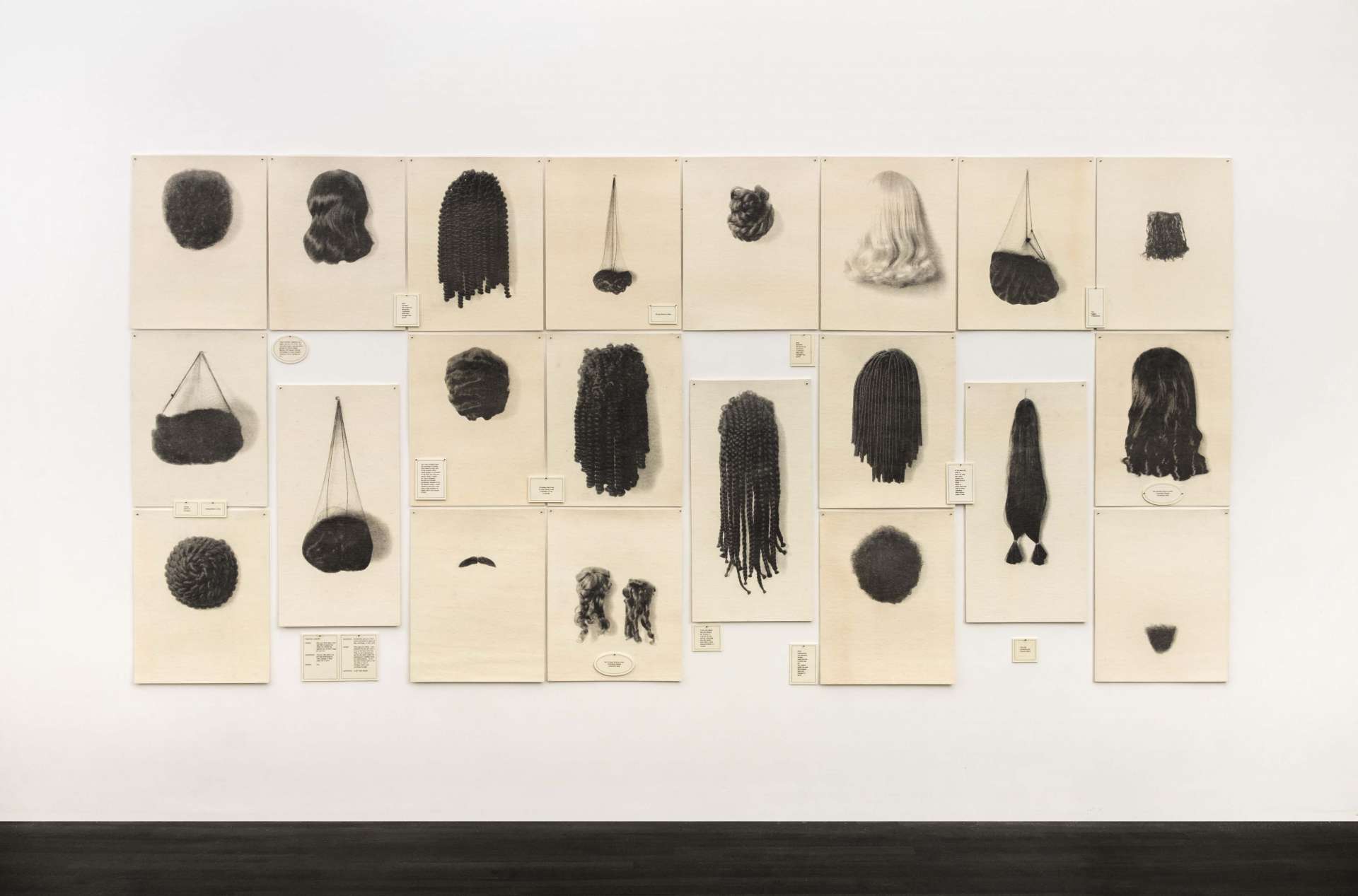
Another work, Easy for who to say, 1989, might be the bridge between this sort of typology and Simpson’s ‘self-repeating images’. Easy for who to say features the same image across its frames, each with a different vowel overlaid on the subject’s face. The vowels form a set, creating a tension between difference and repetition, and perhaps suggesting that the differentiation of these figures comes firstly through language and the act of naming. Otherwise, without language, Easy for who to say’s subjects become one. As Enwezor writes: ‘ … they represent a kind of every black woman. They have no names. No faces. No identity, except their biology’. They become a ‘generic racial and gendered self’.10 In our colloquial understanding of the generic, Enwezor might mean that Simpson’s subjects are emptied out, made unreal in their lack of specificity. ‘Genericism’ in its popular usage is tied to universality; when we talk about the ‘generic’ we might think of stock imagery, meant to be devoid of perspective and affiliation.
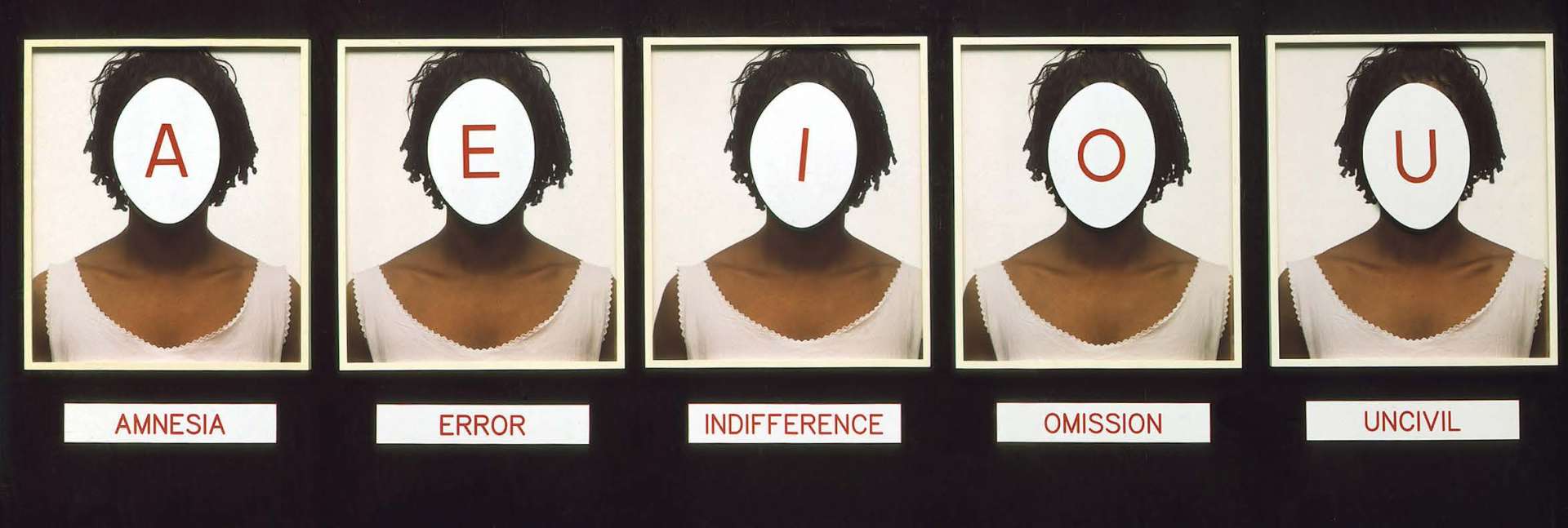 Easy For Who To Say L. Simpson (1989)
Easy For Who To Say L. Simpson (1989)However, François Laruelle gives generic new life in his non-philosophical inquiry, which aims to analyse philosophical systems for the presence of the generic within. As mentioned before, Laruelle’s generic forms ‘an average universal or middle ground between the One-All and singularity or individuality’, which ‘is capable of supporting a multiplicity of heterogeneous acts or predicates’.11 The generic is an aesthetic and ontological proposition. Considering Laruelle, Simpson’s generic portraits open up onto a new terrain: the black generic.
The black generic is not a new proposition, but rather a re-articulation of a black non-ontology derived mostly from Fanon. Many others take it up – notably Glissant and Moten in their interest in black subjects’ ‘consent not to be a single-being’.12 However, such formulations run the risk of insufficiently balancing the weights of the collective and the individual, still burdened by the binaries of Western philosophy. This is of particular concern when dealing in the world of images, where despite theories of non-ontology and collective identity, black subjects retain the appearance of ontological integrity within the picture plane, the camera historically purporting to produce this integrity through photographic capture. The black generic abandons this pursuit, choosing neither a new universalism nor a radical multiplicity. Instead, the black generic operates from an acceptance of the implicit ‘consent not to be a single-being’ involved in black existence and aims to draw out and image this condition. The black generic forms that ‘middle ground between the One-All and singularity and individuality’, and accommodates both the discrete and the continuous, the individual and the collective identity.
Where else is the black generic? For one, it might be everywhere. The generic is not an objective, but a way of seeing or orienting oneself. So, as in Laruelle, the task is less to encourage a consciously generic aesthetic and more to identify it where and when it already exists. I am of the mind that it might exist en masse in the work of black artists, whether explicitly articulated or not. It exists increasingly in contemporary artists’ work today, following the moment of interest in a colloquially generic aesthetic at large in ‘post-internet’ circles. It is not surprising that the generic resides dormantly in much contemporary art, as the repetition and circulation of images is a precondition of existence, as well as quite easy to achieve. The placement of images together as though to form a typology is even built into the infrastructure of platforms like Instagram.
But the black generic is explored rather directly in the works of certain artists working today. Like the work of Simpson, they serve as more glaring examples, and could be instructive towards identifying a black generic elsewhere.
Martine Syms’s Notes on gesture, 2015, models something like a black generic, intersecting with Simpson while diverging formally in a number of ways. Notes on gesture is a short video work that features artist Diamond Stingily running through a series of hand motions and spoken idioms in front of a backdrop in Syms’s signature purple hue. Stingily mimes hand gestures that are patently those of black women, each gesture cycling over and over before switching to the next. Notes on gesture takes a staged approach to the image, similar to Simpson’s, where the subject’s surroundings are sparse and artificial. The video feels like a screen test, while Simpson’s photographs look like studio photography. However, here, Syms has made a moving image instead of a series of photographs, and Stingily’s face is featured centrally; it is not hidden. Instead of repeating her subjects’ presence across a series of picture plans or frames, Syms repeats her across the frames of the film. Stingily loops rapidly, at a speed that would feel familiar to consumers of online videos and GIFs. The looping serves to abstract the subject, like saying a word so many times that it begins to feel or sound like nothing in particular. What remains is a performance of an affect that postures a kind of universalism.
Coincidentally, Sondra Perry’s series White Sheets, 2014, also focuses on hands in its figuring of a generic aesthetic. One could probably write another essay on Syms and Perry’s shared interest in gesture in these works, but in practice, Perry’s photographs are more in the world of Lorna Simpson. White Sheets is a series of portraits without a fully identifiable subject; the only clue to the fact that the subject is a black woman is her hands. Otherwise, she is enveloped in a white sheet. Shown across numerous photos – which I initially accessed via Perry’s website, where they are arranged in a vertical scroll – the figure appears to be draped in the very backdrop cloth that sets the stage for the image, making the black woman not simply the photo’s subject but also a part of the universe that grounds the image. The images also call to mind ghosts, at once present and absent. As well, cloaked in white sheets, the figures are cloaked in whiteness itself, and all its neutrality and subsequent colloquial genericism. Hinting at a black détournement of the properties on a colloquial level, the images gesture towards an always already-black generic on a philosophical plane.
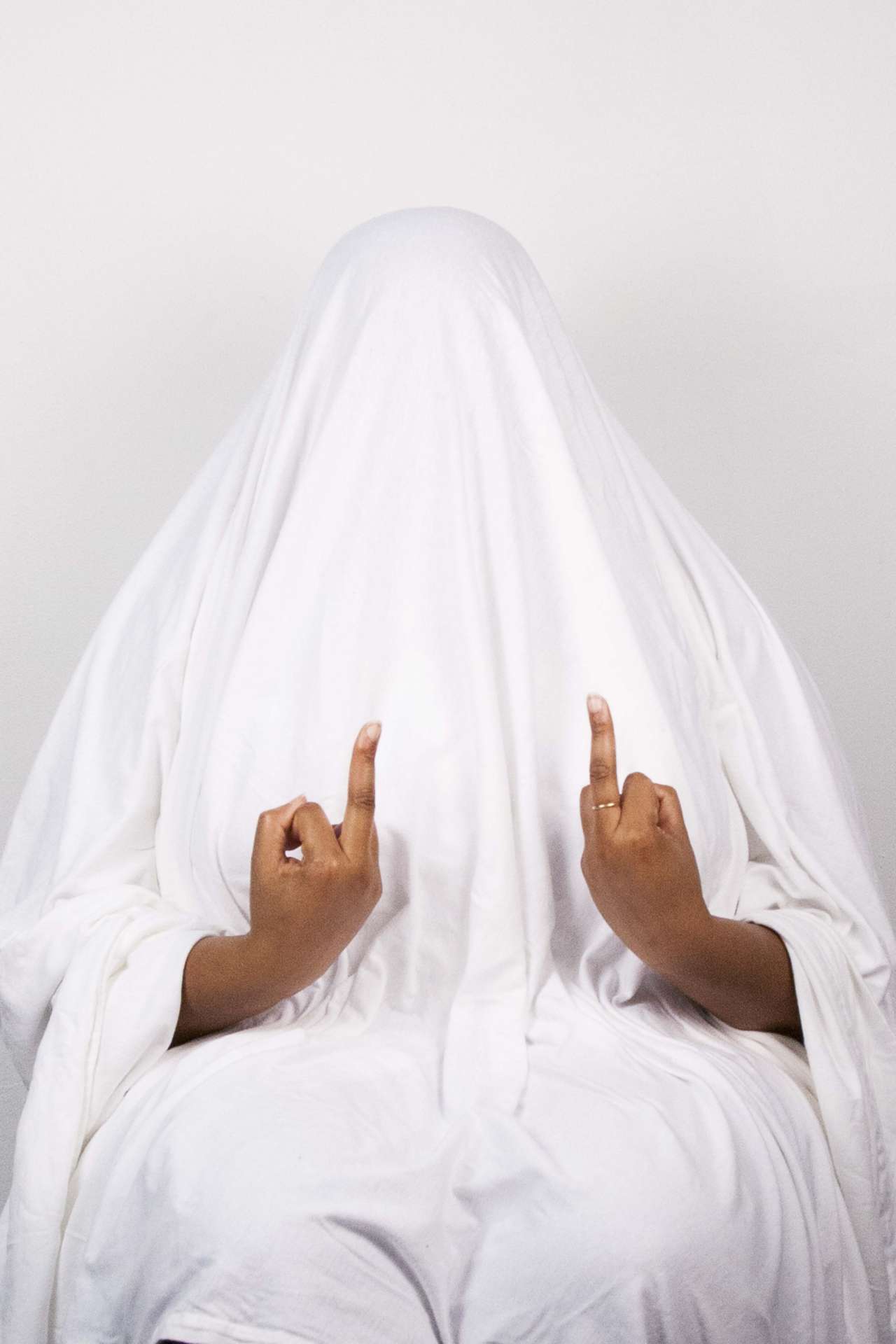 Sondra Perry-White Sheets, 2015
Sondra Perry-White Sheets, 2015Epson Inkjet Print on Matte Kodak Paper
12 x 18 inches
2014 Images Courtesy the artist
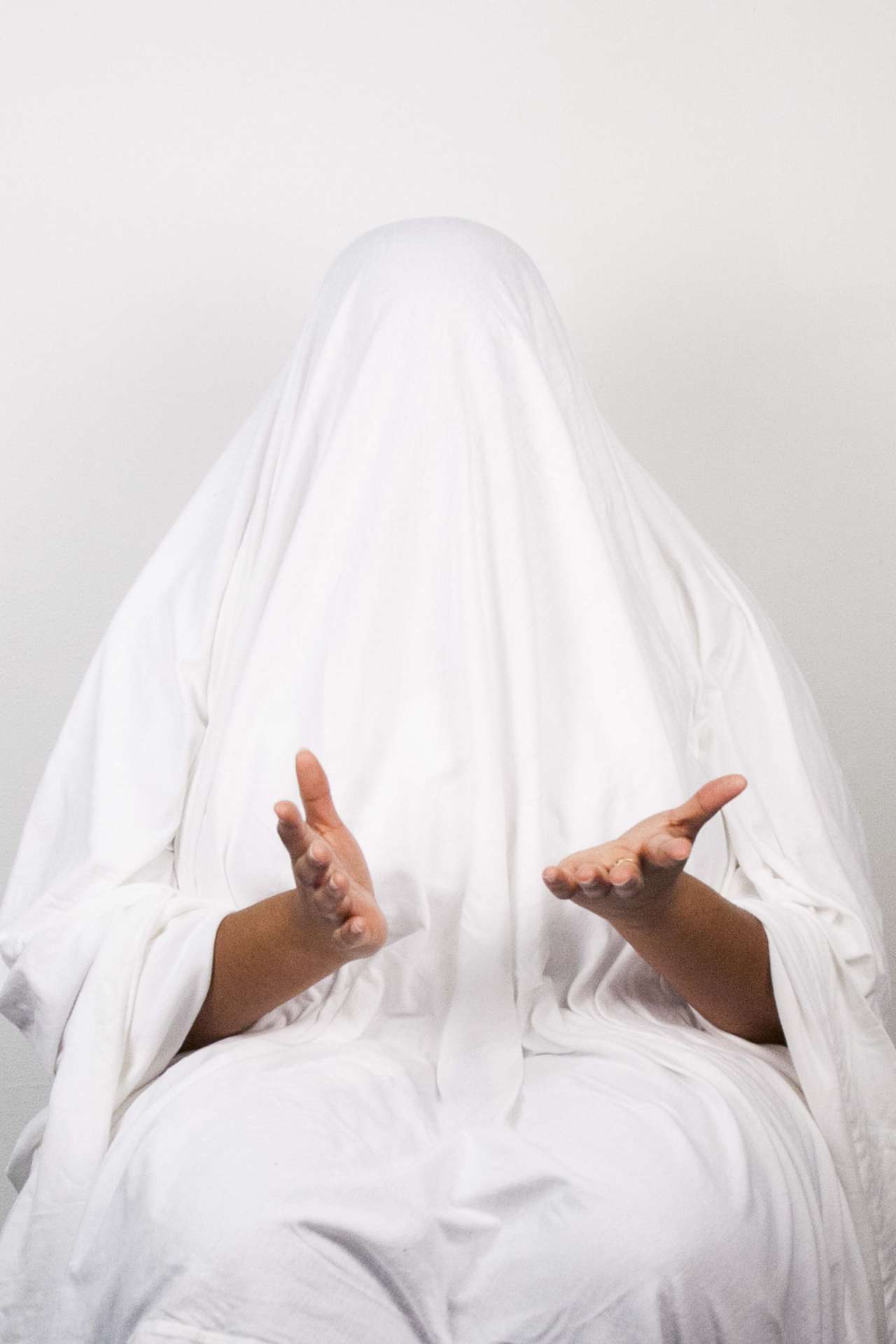
Sondra Perry-White Sheets, 2015
Epson Inkjet Print on Matte Kodak Paper
12 x 18 inches
2014 Images Courtesy the artist
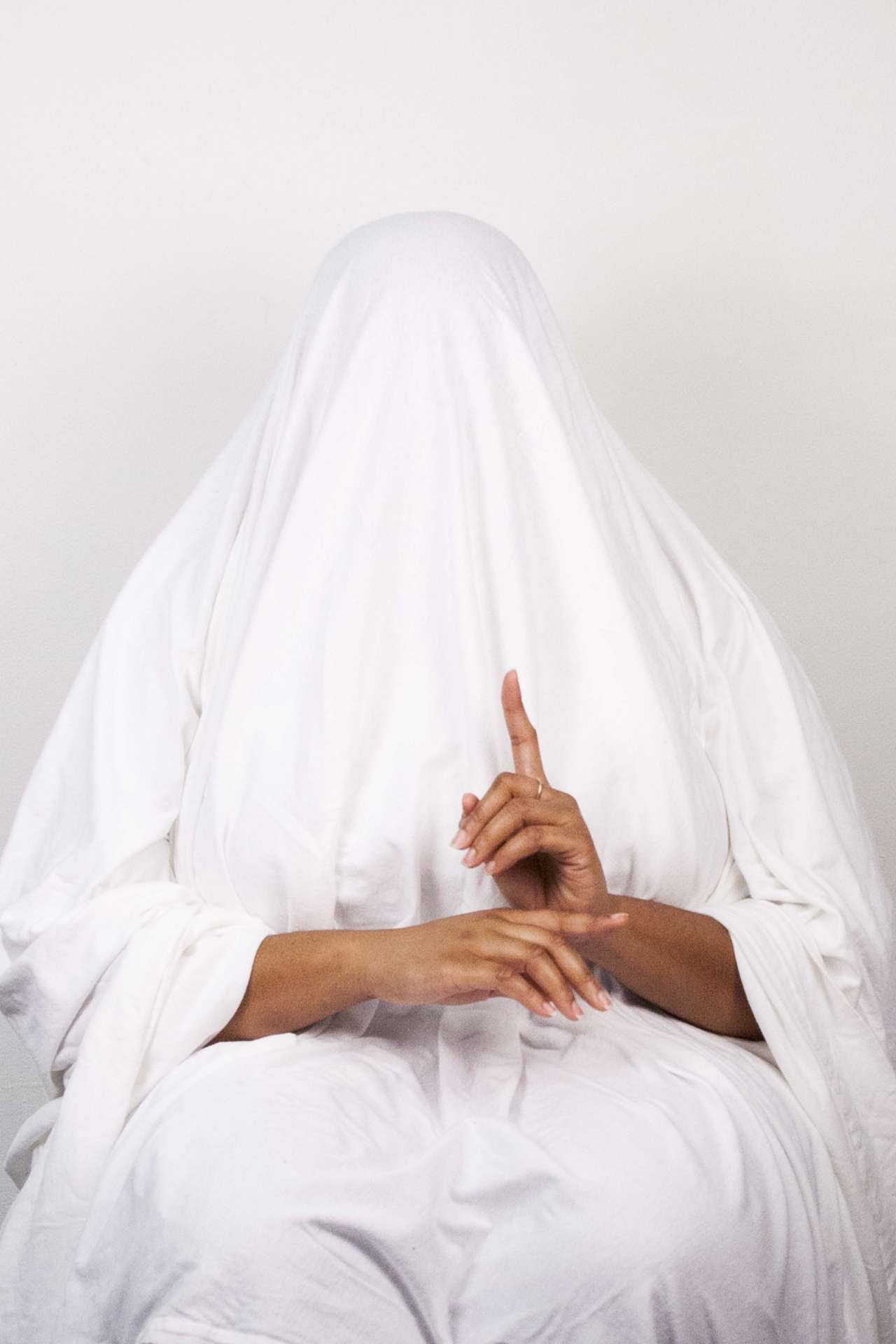
Sondra Perry-White Sheets, 2015
Epson Inkjet Print on Matte Kodak Paper
12 x 18 inches
2014 Images Courtesy the artist
I have tried to map lightly, as stated at the outset, another possible matrix upon which to evaluate the black photographic image or the photographed black subject. It is my hope that these notes can begin to unfold a way of dealing with these images that can accommodate a relationship between representation and abstraction that converts conflict into another force, and better speaks to a black ontology. For instance, it is my hope that the black generic might lend itself to understanding the work of photographer Zanele Muholi, whose work appears here, as something more than an archive or typological documentation of queer black South Africans with the humanist aim of articulating diversity and multiplicity among individuals, but rather exploring such a practice’s ontological import.
Black artists are continually grappling with the question of the collective and its relationship to the individual, which feeds into grappling continually with abstraction and representation. Representative photographic practices – portraiture, we could go ahead and call it – have the potential to do more than endorse representation as a tactic. Rather, they act as a cipher for an ongoing philosophical and ontological inquiry into the situation of blackness, the black photographic subject and the image, at times providing proof of concept for a network of theoretical attempts to bring to life the tricky apparent paradox of black (non)life.
Aria Dean is an artist, writer and curator based in Los Angeles. She currently holds the position of assistant curator of net art and digital culture at Rhizome. Her writing has been featured in Artforum, Art in America, The New Inquiry, Real Life, Topical Cream, Mousse Magazine, CURA and X-TRA Contemporary Art Quarterly. She has exhibited at Arcadia Missa (London), Knockdown Center (New York) and Chateau Shatto (Los Angeles), among other venues.
References
1. Museum of Contemporary Art, ‘Introducing: Lorraine O’Grady and Juliana Huxtable’, , accessed 21 Jul. 2017.
2. François Laruelle, ‘The Generic Orientation of Non-Standard Aesthetics’, lecture, University of Minnesota, 17 Nov. 2012, translated by Drew S. Burk, Joe Hughes, Christophe Wall-Romana.
3. Ulysses Jenkins, Two zone transfer, video, 1979.
4. Kara Keeling, ‘“In the interval”: Frantz Fanon and the “problems” of visual representation’, Qui Parle, vol. 13, no. 2, Spring/Summer 2003.
5. Frank B. Wilderson III details this history in Red, White & Black: Cinema and the Structure of U.S. Antagonisms, Duke University Press, Durham, 2010.
6. Okwui Enwezor, ‘Repetition and differentiation – Lorna Simpson’s iconography of the racial sublime’, in Lorna Simpson, Abrams, New York, 2006, p. 120.
7. ibid. p. 119.
8. ibid. p. 120.
9. Blake Stimson, ‘The photographic comportment of Bernd and Hilla Becher’, Tate Papers, no. 1, Spring 2004, , accessed 24 Jun. 2017.
10. Enwezor, p. 120.
11. Laruelle, lecture, University of Minnesota, 17 Nov. 2012.
12. See ‘One world in relation: Édouard Glissant in conversation with Manthia Diawara’, Nka Journal of Contemporary African Art, no. 28, pp. 4–19.